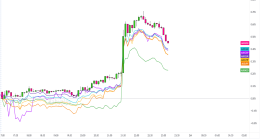
Why these entrepreneurs bet on nostalgia for the old soda brand.
February 5, 2019 7 min read
This story appears in the January 2019 issue of Entrepreneur. Subscribe »
Remember Slice?
Not the pizza. Not the Grandmaster Slice hip-hop guy.
The soft drink.
Even an answer of “kinda sorta” could mean money in the can for the people bringing back Slice, the ’90s PepsiCo pop. The twist: It won’t (sorry, diehards) deliver that sinfully sweet blast of sugary, citrusy nostalgia — nor will it be made by PepsiCo. The Slice hitting the shelves in early 2019 is a 25-calorie sparkling water made purely with organic juice, and it’s based on a bet by two eagle-eyed entrepreneurs who wrested the trademark away from its original owner: Given how important branding has become, their theory goes, a startup can gain an instant advantage in the marketplace if it’s using a brand name consumers are already familiar with … even if the product is different from what they remember.
There’s a certain illogic to this theory, but Chicago entrepreneur Mark Thomann has done it before. His company, Dormitus Brands, “pays homage to the idea of a sleeping giant that’s ready to wake up again,” he explains — which is to say, he watches for when companies allow their discontinued brands’ trademarks to lapse, and then he leaps in, claims ownership (which is perfectly legal), and revives them. He’s succeeded with Brim, which began life as a General Foods decaf staple of the ’70s (he turned it into a line of artisanal coffee equipment); the iconic audio equipment brand Aiwa (now a new electronics brand); and most recently, the Bud Light dog mascot Spuds MacKenzie (which he plans to transform into a canine health-and-wellness line).
But how far can this strategy stretch? Slice will become a useful case study.
Related: What Entrepreneurs Need to Know About Trademarks
Dumpster diving for these iconic names isn’t actually that easy. There’s no Dead Brand Digest or eBay for Trademarks that sends an alert to your inbox when a name frees up. So the journey begins with some guesswork. This one started with lawyer Joseph Gioconda, a top IP litigator and the founder of Gioconda Law Group in New York, who has worked with Thomann on previous cases. “In late February of 2016,” he recalls, “my wife and I were in the kitchen at my in-laws’, and I was talking to her about my work with Mark. And she says, ‘What about Slice?’ ” What about it? He took out his iPad and found that PepsiCo had seemingly allowed its federal trademark registration to lapse. He called and emailed the company’s customer service reps and was told that Slice had been discontinued. (PepsiCo did not respond to requests to comment.) Gioconda got excited and told Thomann of his discovery. Could this be another brand revival?
“Soda? Naaaah,” replied Thomann. But he kept thinking on it. “After a few months,” he says, “it hit me: There’s an opportunity here.” What Thomann saw was a decline in soda consumption and a surge in sparkling water sales — and, most important, a gap between them. True enough, from 2012 to 2017, the total volume of carbonated soft drinks sold in the U.S. decreased about 7.8 percent, according to the market research provider Euromonitor International. Meanwhile, Nielsen reports that the sparkling water category grew 54 percent over the past four years. In between those two categories, however, there wasn’t much to choose from. For someone trying to get off soda, the switch to the no-sugar, flavored waters — your Dasani, your LaCroix — meant a big and painful leap. (The exception now is Spindrift, a bubbly water made with real juice. But Thomann is not a fan.) “So to create a Slice that has a little bit of sweetness but is still very healthy and delicious — that to me was interesting.”
Gioconda got busy getting the trademark. The litigation took almost two years — the type of work, he says, that can cost hundreds of thousands of dollars. But instead of charging, he decided to partner with Thomann in New Slice Ventures. “It was pure serendipity,” he says. “I think it was the day after PepsiCo had passed the point of no return, where it could not renew the trademark, when we jumped in.” Had they missed that window by a couple of months, somebody else could have beaten them to it.
With trademark in hand, New Slice Ventures partnered with Revolution Brands, a company that develops food brands, to create the product and get it into stores. The timing was good: Revolution was already working on a healthy soda alternative. It came up with four flavors — blackberry, pineapple-mango, apple-cranberry, and raspberry-grapefruit. “People fall into two camps,” says Ian Abbott, managing partner at Revolution. “They like either the first two, which have a smooth, clean, sweet profile, or the last two, because some people need that tart bite of a finish.”
This new Slice has few echoes of the old. Gone is the party-animal, comic-book mojo; the new can has a fresh, delicate appeal. Even its once-bold letters have slendered to a willowy font. Which raises a question: Why not just debut the drink as a whole new brand? Gioconda says their own surveys found two out of three people didn’t remember the ’90s Slice. But for those who do, Thomann argues, “I think the brand name acts as an accelerant.”
Brand experts are split on this wisdom. “It could be a very fleeting moment where people think, Wow — Slice is back; pick up a six-pack. And then they drink it and it tastes, you know, weird. Like, What a bummer,” says Matthew Stumm, founder of the Boston branding agency Stark/Raving, who has worked with Eli Lilly, Dell, and MAD Magazine. The Brim example makes more sense to him; that was subpar coffee nobody’s clamoring to have again, so relaunching it to sell coffee equipment is simply a brand extension. But Slice? “It would take a lot of money to change people’s perceptions that the Slice of 1990 is not the Slice of 2019. It’s like the old saying: Is the juice worth the squeeze, man?”
Others are more optimistic. “Historically, the brand was about fun and flavor, so they have a huge opportunity, really, to lean into that,” says Jonah Fay-Hurvitz, strategy director at Red Antler, the buzzy Brooklyn company whose clients include Casper, Brandless, and Allbirds. He sees a straightforward story for the new Slice to tell. “You’ve got to frame the old brand for today,” he says. “If I’m a consumer, I’m saying, ‘Oh, wow; Slice is seeing how people’s desires have shifted and is modern enough to evolve.’ It shows that the brand is awake.”
Related: 3 Things I Learned After Having to Change My Business Name
Thomann and Gioconda are certainly hoping their sleeping giant will awaken enough to attract thirsty fans — and, perhaps, for PepsiCo or one of the other huge soda companies to buy it back.
“I mean, they could be sitting on a gold mine,” says Stumm, the Slice pessimist, laughing. “And if a year from now I’m drinking healthy Slice, I’ll call you and be like, ‘I’m totally wrong; this thing is delicious.’ ”
Consumers will decide. A four-pack now retails for an MSRP of $3.99.
This article is from Entrepreneur.com







